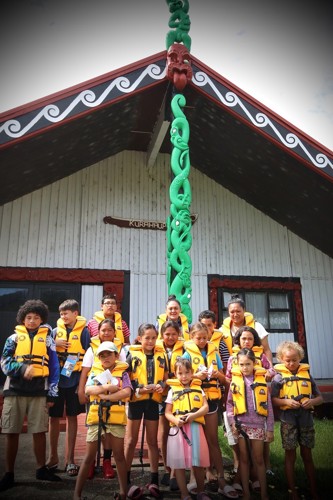Life jacket ‘library’ underway in Far North
22 Dec 2021, 9:19 AM
Several remote Far North communities are benefitting from an innovative ‘life jacket library’ initiative designed to encourage safer boating behaviour and life jacket use.
The scheme is being implemented by Northland Regional Council contractor Les Bore who works with the council as its Far North safety ambassador to coordinate improving navigation safety outcomes in the area’s remote communities.
The initiative forms part of Northland Regional Council’s localised ‘Nobody’s Stronger than Tangaroa’ campaign which aims to address lack of skipper knowledge and responsibility, failure to wear life jackets/compliance, speed and wake, and alcohol use on the water.
Councillor Colin ‘Toss’ Kitchen, who represents the council’s most northernly Te Hiku constituency, says the NRC received $70,000 in funding from Maritime NZ toward the campaign, with about $10,000 used to purchase the life jackets.
 Students and teachers from Kua ā-Iwi o Pawarenga (Pawarenga School) with their new lifejackets.
Students and teachers from Kua ā-Iwi o Pawarenga (Pawarenga School) with their new lifejackets.
Typically, each area targeted gets about 20 life jackets which it can then lend out to locals as it sees fit, the rationale being that the recipients know how to maximise the benefits from the scheme, whether that be lending them out for just a few hours or longer-term.
“Life jacket loans – including the length of time they’re out for – will be managed by the communities themselves, and they’ll also be responsible for undertaking COVID-19 protection procedures in-line with their current policies.”
The council is currently in the middle of distributing a total of 120 life jackets – some of which would usually retail for up to $140 each – to a number of Far North communities with Pawarenga and Ahipara among the early beneficiaries.
Councillor Kitchen says the council hopes to get a third batch of life jackets to the Awanui area shortly and staff are working through potential recipients for the remainder, with everything from deserving families to marae and other community organisations considered.
Mr Bore says of this year’s recipients, Kua ā-Iwi o Pawarenga (Pawarenga School) was given 19 lifejackets, mainly children’s sizes, in early December with a couple of larger examples for teachers.
He says the school is right on the water’s edge and has pupils aged six to 13 years, including several who had not yet learned to swim.
Waka ama, swimming and other water-related activities were popular in the area and the school had been relying on just four aging life jackets before the donation.
Meanwhile, another 20 life jackets will also go to Ngati Kuri’s marae at Te Kao which got 10 life jackets last year and which had sowed the seed for the wider life jacket library scheme.
“Technically this is the second season this initiative has operated...last year was more about finding out how small communities operate. They’re kind of self-sufficient and tend to rely on themselves rather than external agencies.”
Mr Bore says last year had seen him meet with kaumatua and other locals and the council had sponsored some fishing contests with buckets and dive flags.
It was through these interactions he came up with the idea of keeping lifejackets together in a hub to ensure they were regularly used/available to wider community.
